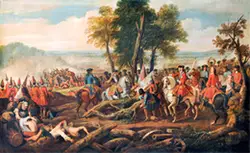Charles VI: Holy Roman Emperor, King of Germany
Charles VI was Holy Roman Emperor and King of Germany for a time in the early 18th Century. He is most well-known for the introduction of the Pragmatic Sanction, by which he hoped to have his daughter succeed him on the imperial throne. 
He was born on Oct. 1, 1685, in the Hofburg Palace in Vienna. His father was the reigning Holy Roman Emperor Leopold I, and his mother was Eleanore Magdalene of Neuburg. Charles's mother was Leopold's third wife, and Charles was Leopold's fourth son. Neither of the first two boys survived long after their birth. Leopold's third son, Joseph (born in 1678), did and became the heir apparent from a very early age. His father named him Archduke of Austria when the boy was 6 and King of Hungary three years later. Young Joseph achieved the coveted title of King of the Romans (Germany) in 1690, taking a throne that had been vacant for some time. 
Spain's King Charles II had no children and so, in 1700, named young Charles as his successor. At that time, Charles was only 15; however, he was a Habsburg, as was the Spanish king. By the time that Charles II died, however, the king had changed his mind, naming as his successor Philip of Anjou, the grandson of France's King Louis XIV. The War of the Spanish Succession ensued, and Charles was to be the beneficiary of an imperial victory, punctuated by victories that his forces won in Barcelona and Madrid. However, the victory was not as complete as he wanted it to be. Leopold I died in 1705, and Joseph I succeeded him. Joseph, in turn, died in 1711, in the waning days of the war. Charles then took over the thrones of the Empire and of Germany, on Oct. 12, 1711. That single event, more than any other, determined the outcome of the war, as one after another of his allies turned on him, refusing to bring back the massive realm ruled over by Charles V in the 16th Century. Three years later, a pair of treaties ended the war, with Philip holding on to Spain and Charles gaining the former Spanish possessions Milan, Naples, Sardinia, and the Austrian Netherlands. Charles had married Elisabeth Christine of Brunswick-Wolfenbüttel on Aug. 1, 1708. They had two daughters, Maria Theresa and Maria Anna, both of whom survived into adulthood. Eager to maintain Habsburg rule, Charles in 1713 issued the Pragmatic Sanction, bypassing the Salic Law requirement that only men could inherit the realm. Charles also involved himself and his empire in more wars, in 1718 defeating Turkey and gaining lands in Hungary and Serbia, two years later winning the War of the Quadruple Alliance, and backing the winning candidate (Augustus of Saxony) in the War of the Polish Succession (1733–1738). Near the end of that struggle, which was more a technical victory and resulted in the loss of some key Italian lands, came another Austro-Turkish War; this time, Turkey prevailed. Peace reigned for a time, as Charles struggled to rebuild his army and pay his debts. He died on Oct. 20, 1740, in Vienna, not recovering from an illness. His intended successor, his oldest daughter, Maria Theresa, had to fight for her right to rule, in the War of the Austrian Succession. |
|
Social Studies for Kids
copyright 2002–2024
David White




